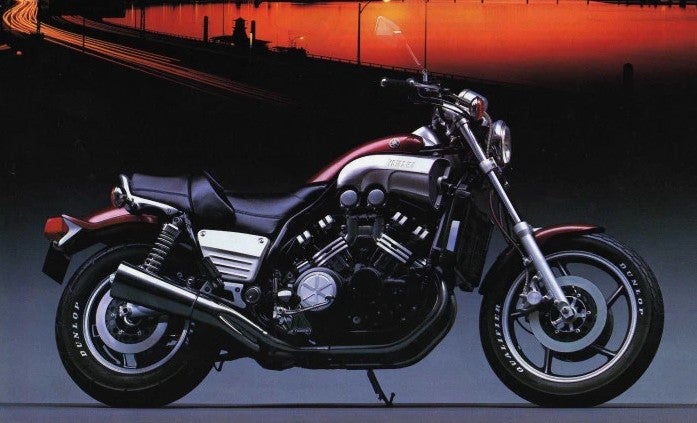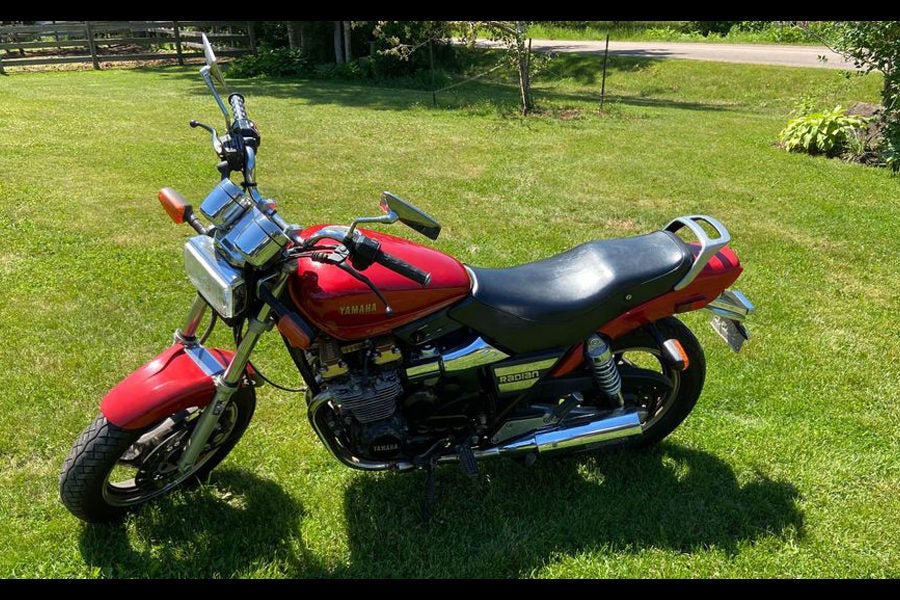Everyone’s looking for the do-it-all bike, and when you factor offroad performance into that equation, it’s pretty hard to achieve that goal. But what if you were building a bike only for pavement? Could you make a machine that combined touring bike practicality with sportbike thrills and muscle bike posing?
You could argue about whether or not the project was successful, but Yamaha certainly tried to do this in the 1980s, with the Radian. When it hit the scene in 1986, it could have been the perfect all-rounder for the street—at least, for buyers on a budget.
Empty the parts bin!
The oddly-named Radian came along in 1986, which was right in the middle of the Gold Age Of The Japanese Muscle Bike. Yamaha had just released its massively powerful V-Max boulevard blaster the year before, which was certainly the king of its competitors (and it remained there for many years). Kawasaki was building the Eliminator series, with sportbike engines combined with cruiser-style frames. Suzuki had the Madura V4, Honda had the Sabre line, with the V65 liquid-cooled V4 engines. The Magna line also had some muscle bike pretensions as well.

This promotional image of an ’86 V-Max shows the muscle cruiser styling the Radian aimed for.
As always, there were customers who couldn’t afford the top-line engines, or didn’t feel they needed the power, or just didn’t want them. Most of the OEMs had a machine to fill that niche too; Honda had the V45 series, Kawasaki had the 600 Eliminators.
Yamaha took the air-cooled four-cylinder engine from its FZ600 sportbike, and gave us the Radian—aka the “Wee-Max.”
When manufacturers repurpose a sportbike engine into a more sensible machine, they always re-tune it, and the Radian was no exception. With a four-valve-per-cylinder DOHC top end, it was still definitely on the sporty side, but it didn’t have the FZ600’s oil cooler (Radian owners have been known to graft on the FZ600’s cooler, though!).

That 3.2-gallon tank wasn’t huge, but certainly more practical than some other machines in this category. Photo; Facebook
It had smaller carburetors than the FZ600 (Mikuni BS30 30-millimetre, as opposed to 32-millimetre), and there were other modifications to make it better suited for street riding. At the end of all the changes, the Radian was rated for anywhere between 60 to 66 horsepower at 9,500 rpm, depending whose testing you believed. “Wee-Max” indeed! While far behind its V4 stablemate, that’s still plenty of jam for the real world, especially in the mid-80s, and customers did not seem to whine about a lack of power. Some might have preferred more low-end torque, but with a sporty 600, you have to take what you can get—there wasn’t any chance of converting this into a stump-puller (it was rated for about 38 pound-feet of torque at 7,500 rpm).
The Radian had a six-speed gearbox with chain final drive, unlike some of Yamaha’s other four-cylinder standards—the XJ series’ shaft drive remains one of the best features of those machines, to this day.
Yamaha put dual disc brakes up front on the Radian, with a drum brake in rear. Yuck. Dated by today’s standards, but pretty common in the mid-’80s.
Price point was a very important consideration with this machine. It wasn’t just the motor; many of the parts were lifted from other machines in Yamaha’s lineup, and the suspension was pretty wimpy. In keeping with the muscle bike theme, plenty of other parts had chromed finish, but many of these bits were plastic underneath. Again, yuck. Hey, it was the ’80s.
- From the rear, the styling … wasn’t terrible. Photo: Facebook
- From the front: A face only a mother could love. Photo: Facebook
Owning a Radian
Most of Yamaha’s streetbikes of the 1980s have a good reputation for longevity, and the Radian certainly fits into that mold. These bikes were well-regarded over their 1986-1990 production run. And, here’s a bit of a puzzler: These bikes were very affordable in their day, and you’d think that would mean ownership by cash-strapped hooligans who didn’t take care of their bikes (that is to say, the stereotypical buyers of second-hand Harley-Davidson Sportsters).
And yet, there seem to be plenty of Radians on the used market in fairly decent cosmetic condition. All that plastic-painted chrome was chintzy, but did it keep owners motivated to store their bike indoors? Hard to say, but 35 years after the bike’s introduction, many Radians survive in respectable shape.
Maybe they aren’t the prettiest bike in the world. In fact, you could say that square headlight is butt-ugly. However, they are not without aesthetic charm when viewed from the side or the rear.
The Radian’s upright ergos are comfortable. This is a bike you can ride to the grocery store across town, or across the state, or across the country. While primarily a bike for riding locally, many, many of these were pressed into long-distance riding duty. There is a great Ride Report in the ADVrider forum with ruffntuff’s description of a ride from Virginia to Alaska, and back, on an ’86 model.

No question, even with a low 16,000 kilometres on the odometer, this ’86 model is in good shape, but not as-new. Photo: Facebook
What about this bike?
The machine in this photos is for sale in Prince Edward Island, Canada, priced at $3,000. Yikes! That’s probably more than the original Canadian MSRP (certainly more than the original American MSRP). Despite the Radian’s charms, many buyers would likely shy away from spending $3k on a bike that was always a budget machine from the start. And, this machine isn’t exactly cosmetically perfect either, although it is in pretty good nick.
If you must have it—see the ad here on Facebook Marketplace.









